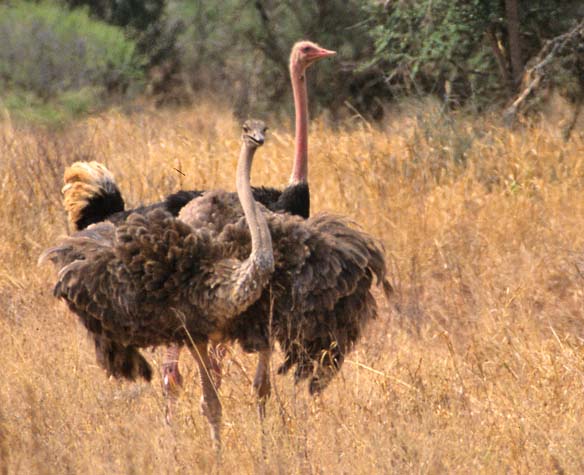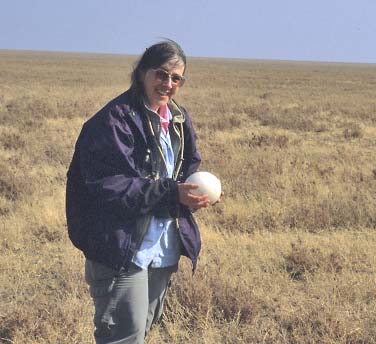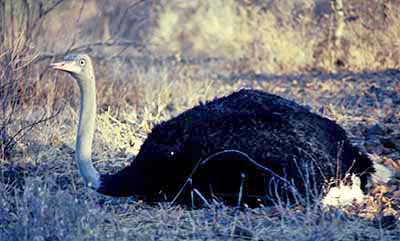
a web page by Don Roberson |
OSTRICH Struthionidae |
|
 |
Males defend territories in the African veldt. In some places they are monogamous, but in other locales they tend harems of females. These social systems can be complex, with the "major hen" and the male doing the incubating and care of the young, while "minor hens" mate with the harem owner or other males, and lay eggs in the same nest, but do not incubate (Folch 1992). Traditionally there was but a single species of Ostrich but African populations have recently been split into two species. All the photos at the top of this page show the pink-necked, pink-legged Common Ostrich.
|
The primary adults guard the young and protect them from predators as best they can, including the use of a variety of distraction displays. Yet breeding success is quite low. Only ~10% of eggs hatch, and then the precocial young are often taken by predators. Fortunately, Ostriches are long-lived because in studies in Kenya, for example, only 0.15 young are raised each year from each adult (Folch 1992). Thus in many years the effort to raise young to independence will fail. Ostriches once roamed throughout open areas of all of Africa and in the Middle East, but they were hunted for food and plumes in the 19th century and the world population is much smaller today. The Middle Eastern race syriacus became extinct by about 1966. Today, Ostriches exist in the Western Palearctic only in southeastern Egypt. |
There
is another blue-necked race in southwestern Africa where the
populations are very fragmented. Ostriches in South Africa — such as
Kruger National Park — are all introduced birds, often of the
pink-necked sub-Saharan nominate race or feral individuals of unknown
race. |
Photos: The pink-legged Common Ostrich Struthio camelus massaicus were photographed in the Masai Mara, Kenya, in Nov 1981 (top photo) and Tarangire Nat'l Park, Tanzania, in Aug 2002. Rita is holding the Ostrich egg found near Ndutu, Tanzania, on 6 Aug 2002. The blue-necked Somali Ostrich S. molybdophanes was photographed by my father, B.B. Roberson, in Samburu Nat'l Park, Kenya, in Oct 1981. Photos © D. Roberson and © B.B. Roberson, respectively; all rights reserved. Bibliographic note: There is no "family book" per se of which I'm aware (there are numerous coffee-table "survey" books that include Ostrich among other large flightless birds), but an excellent introduction to the family is in Folch (1992). Literature cited:
|
 The sight of a male Common Ostrich
(above) striding across the east African plains is an impressive one.
It is the world's largest bird, standing taller than a man and weighing
up to 150 kg (=330 lbs). It has great legs, and can sustain speeds of
50/km per hour for about half an hour.
The sight of a male Common Ostrich
(above) striding across the east African plains is an impressive one.
It is the world's largest bird, standing taller than a man and weighing
up to 150 kg (=330 lbs). It has great legs, and can sustain speeds of
50/km per hour for about half an hour.  Ostrich
eggs are huge, and weigh about as much as two dozen eggs from your
favorite supermarket. The eggs are laid in very rudimentary scrapes on
the ground, and incubated. One ostrich can incubate up to 25 eggs, but
most nests have even more because of the extra ones laid by "minor
hens." The "major hen" puts her own eggs in the middle but she still
incubates some of the 'extra' eggs. We once found a lone egg on the
open plains of Tanzania (right).
Ostrich
eggs are huge, and weigh about as much as two dozen eggs from your
favorite supermarket. The eggs are laid in very rudimentary scrapes on
the ground, and incubated. One ostrich can incubate up to 25 eggs, but
most nests have even more because of the extra ones laid by "minor
hens." The "major hen" puts her own eggs in the middle but she still
incubates some of the 'extra' eggs. We once found a lone egg on the
open plains of Tanzania (right).  The blue-necked, blue-legged Ostrich ranging from Somalia to northern Kenya is now known as Somali Ostrich (left; male sitting on a nest in a slide by my father).
The blue-necked, blue-legged Ostrich ranging from Somalia to northern Kenya is now known as Somali Ostrich (left; male sitting on a nest in a slide by my father).